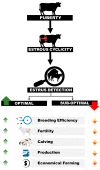Infrared Thermography as a Potential Non-Invasive Tool for Estrus Detection in Cattle and Buffaloes
- PMID: 37106988
- PMCID: PMC10135134
- DOI: 10.3390/ani13081425
Infrared Thermography as a Potential Non-Invasive Tool for Estrus Detection in Cattle and Buffaloes
Abstract
The productivity of dairy animals has significantly increased over the past few decades due to intense genetic selection. However, the enhanced yield performance of milk animals caused a proportional increase in stress and compromised reproductive efficiency. Optimal reproductive performance is mandatory for the sustainable production of dairy animals. Reproductive efficiency is marked by proper estrus detection and precise breeding to achieve maximum pregnancies. The existing conventional methods of estrus detection are somewhat labor intensive and less efficient. Similarly, the modern automated methods that rely on detecting physical activity are expensive, and their efficiency is affected by factors such as type of housing (tie stall), flooring, and environment. Infrared thermography has recently emerged as a technique that does not depend on monitoring physical activity. Furthermore, infrared thermography is a non-invasive, user-friendly, and stress-free option that aids in the detection of estrus in dairy animals. Infrared thermography has the potential to be considered a useful non-invasive tool for detecting temperature fluctuations to generate estrus alerts without physical contact in cattle and buffaloes. This manuscript highlights the potential use of infrared thermography to understand reproductive physiology and practical implementation of this technique through discussing its advantages, limitations, and possible precautions.
Keywords: buffalo; cattle; estrus detection; infrared thermography.
Conflict of interest statement
The authors declare no conflict of interest.
Figures
Similar articles
-
Evaluating automated infrared thermography and vulva exposure tracking as components of an estrus detection platform in a commercial dairy herd.Animal. 2022 Aug;16(8):100585. doi: 10.1016/j.animal.2022.100585. Epub 2022 Jul 25. Animal. 2022. PMID: 35901655
-
Evaluation of infrared thermography combined with behavioral biometrics for estrus detection in naturally cycling dairy cows.Animal. 2021 Jul;15(7):100205. doi: 10.1016/j.animal.2021.100205. Epub 2021 Jun 23. Animal. 2021. PMID: 34171567
-
Infrared thermography and behavioral biometrics associated with estrus indicators and ovulation in estrus-synchronized dairy cows housed in tiestalls.J Dairy Sci. 2019 May;102(5):4427-4440. doi: 10.3168/jds.2018-15221. Epub 2019 Mar 15. J Dairy Sci. 2019. PMID: 30879824
-
Review: Behavioral signs of estrus and the potential of fully automated systems for detection of estrus in dairy cattle.Animal. 2018 Feb;12(2):398-407. doi: 10.1017/S1751731117001975. Epub 2017 Aug 15. Animal. 2018. PMID: 28807076 Review.
-
Application of electronic estrus detection technologies to reproductive management of cattle.Theriogenology. 2002 Jan 1;57(1):137-48. doi: 10.1016/s0093-691x(01)00663-x. Theriogenology. 2002. PMID: 11775966 Review.
Cited by
-
The Potential of Infrared Thermography for Early Pregnancy Diagnosis in Nili-Ravi Buffaloes.Animals (Basel). 2024 Jul 2;14(13):1966. doi: 10.3390/ani14131966. Animals (Basel). 2024. PMID: 38998078 Free PMC article.
-
Assessing Pregnancy's Influence on Rectal and Corneal Temperature in Female Cats.Vet Med Sci. 2025 Jul;11(4):e70482. doi: 10.1002/vms3.70482. Vet Med Sci. 2025. PMID: 40638552 Free PMC article.
-
Infrared thermography as a non-invasive method for evaluating stress in lactating dairy cows during isolation challenges.Front Vet Sci. 2023 Sep 6;10:1236668. doi: 10.3389/fvets.2023.1236668. eCollection 2023. Front Vet Sci. 2023. PMID: 37745218 Free PMC article.
-
An analysis of knowledge, attitude and practice gaps in scientific buffalo husbandry.PLoS One. 2025 Jul 31;20(7):e0327208. doi: 10.1371/journal.pone.0327208. eCollection 2025. PLoS One. 2025. PMID: 40743269 Free PMC article.
-
Fixed-time artificial insemination technology in buffaloes: a review.Front Vet Sci. 2025 Jun 2;12:1586609. doi: 10.3389/fvets.2025.1586609. eCollection 2025. Front Vet Sci. 2025. PMID: 40530030 Free PMC article. Review.
References
-
- OECD. FAO . OECD–FAO Agricultural Outlook 2022–2031. FAO; Rome, Italy: 2022.
-
- FAO . Meat. FAO; Rome, Italy: 2021. pp. 163–177.
-
- Adesogan A.T., Havelaar A.H., McKune S.L., Eilittä M., Dahl G.E.J. Animal source foods: Sustainability problem or malnutrition and sustainability solution? Perspective Matters. Glob. Food Secur. 2020;25:100325. doi: 10.1016/j.gfs.2019.100325. - DOI
Publication types
LinkOut - more resources
Full Text Sources
Miscellaneous



